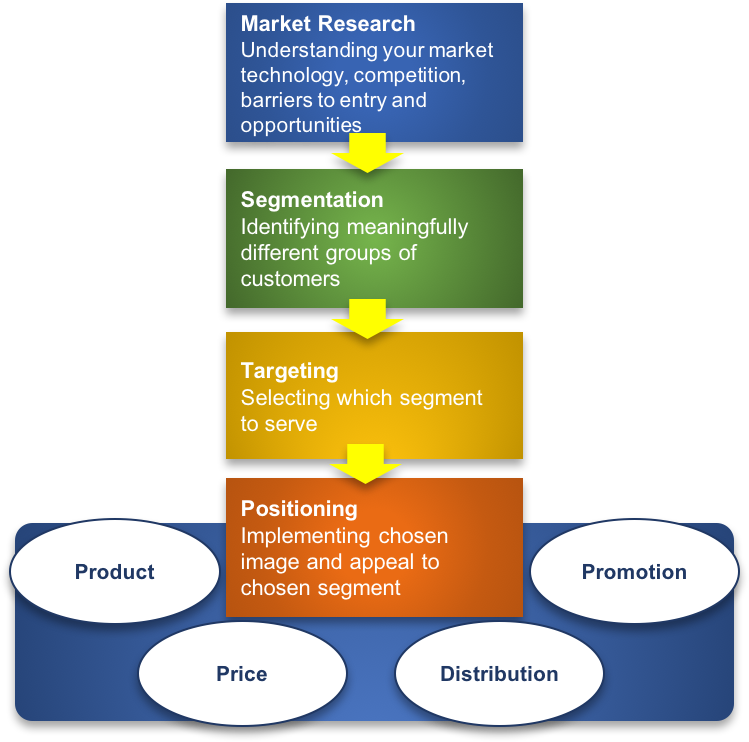 Traditional Marketing Analysis – The best and probably most obvious place to start is at the beginning with a traditional marketing foundation. This holds true whether you are simply planning a new product to add to your portfolio (although this is far far easier), or if you are creating a start from scratch strategy for your business. In the creation of a product or business strategy the most elemental formula – from Drucker and Porter – is to follow the R-STP approach (Research, Segmentation, Targeting, Positioning). First, you do your homework on prospective markets with extensive Research – understand the competitive environment, the nominal value chain, growth rates, profitability of incumbents, and assess the competitive forces (see Porter’s 5 Forces). Then, once you sufficiently understand your proposed market, you Segment the market into distinct, but economically meaningful parts. You segment so that your product offerings, marketing, and channels can be tailored to deliver the highest value for the segment and resonate with your customers. While it may seem attractive to attack the whole market, per almost all strategy experts, this leads to disaster (see Geoffrey Moore’s “Crossing the Chasm”, or Kotler’s “On Marketing”). Careful segmentation allows you to understand how different value propositions will appeal to the different segments of your market and how to approach the different segments with optimal offerings, positioning, messaging and channels.
Traditional Marketing Analysis – The best and probably most obvious place to start is at the beginning with a traditional marketing foundation. This holds true whether you are simply planning a new product to add to your portfolio (although this is far far easier), or if you are creating a start from scratch strategy for your business. In the creation of a product or business strategy the most elemental formula – from Drucker and Porter – is to follow the R-STP approach (Research, Segmentation, Targeting, Positioning). First, you do your homework on prospective markets with extensive Research – understand the competitive environment, the nominal value chain, growth rates, profitability of incumbents, and assess the competitive forces (see Porter’s 5 Forces). Then, once you sufficiently understand your proposed market, you Segment the market into distinct, but economically meaningful parts. You segment so that your product offerings, marketing, and channels can be tailored to deliver the highest value for the segment and resonate with your customers. While it may seem attractive to attack the whole market, per almost all strategy experts, this leads to disaster (see Geoffrey Moore’s “Crossing the Chasm”, or Kotler’s “On Marketing”). Careful segmentation allows you to understand how different value propositions will appeal to the different segments of your market and how to approach the different segments with optimal offerings, positioning, messaging and channels.
Given this understanding, you should then Target the segment where your business with its capabilities, resources and expertise can have the most impact. Finally, for this targeted segment, you create the Positioning for your business. The positioning helps customers understand your value proposition and is traditionally made up of the 4P’s, Product, Price, Place (distribution), and Promotion. While this may seem elementary, if you have not done this, the more advanced strategic planning tools won’t make much sense.
And there is more “groundwork” to do as well. You must also establish some baseline to build off for your company vision, as well as a basic brand identity so that further strategy work will actually move you in the direction you really want to go. From Vision and Brand perspectives, you need to be clear about who you are trying to be as a company.
To use the high-level framework from Kotler’s “On Marketing”, are you trying to be the leader in innovation and product – the Differentiator? Will you focus on efficient and low cost execution – the Low Cost Leader? Or will you focus on narrowly defined needs and markets – the Nicher? Or, per the “Value Disciplines” version of brand positioning, are you the Product Leader, the Operationally Excellent competitor, or focused on Customer Intimacy? While you should align your plan to strongly identify with one leg of this stool, and be as good as you can be at the other two, trying to be all things to all people is a path to failure and will surely make for a muddy strategy. And, all of this feeds into your Vision and your Brand identity. As you set your strategy, you absolutely must have a clear goal of what you are trying to achieve, and what is your vision for the company. As for setting your vision (and a vision statement), the best advice for vision creation is to align your vision with your passions, aim high, stay aligned with your core expertise, and to be sure that your vision is aligned with what drives your economic engine (how you will make money!).
Now, with the basics behind us, we can look and the other classic strategic planning tools.
